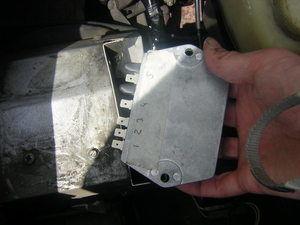Voltage regulator (CAV 440 control unit)
Function

As there is no way to control the voltage output from the generator, an external device is used for this prupose : the voltage regulator.
Source: Second Chance Garage website

As there is no way to control the voltage output from the generator, an external device is used for this prupose : the voltage regulator.
Source: Second Chance Garage website
How to test
1. Connect multimeter set to V-DC to the battery (red on positive, black on ground). One should read little more than 12V (12.6 to 12.8V) for a healthy battery.
2. Crank the engine and let iddle. You should read more than the previous voltage (about 13V )because the alternator is now charging the battery.
3. Pull the throttle and increase from 2000 rpm to 5000 rpm. With a correct voltage regulator you should see the voltage rising to a certain voltage but not exceeding this voltage, whatever the rpm.
Source: Diverse
1. Connect multimeter set to V-DC to the battery (red on positive, black on ground). One should read little more than 12V (12.6 to 12.8V) for a healthy battery.
2. Crank the engine and let iddle. You should read more than the previous voltage (about 13V )because the alternator is now charging the battery.
3. Pull the throttle and increase from 2000 rpm to 5000 rpm. With a correct voltage regulator you should see the voltage rising to a certain voltage but not exceeding this voltage, whatever the rpm.
Source: Diverse
What happens if a regulator fails ?
A failing regulator shall result in a too hight voltage in the electrical circuit. This will burn the bulbs and deteriorate any electrical element.
Source: Diverse
A failing regulator shall result in a too hight voltage in the electrical circuit. This will burn the bulbs and deteriorate any electrical element.
Source: Diverse
Which regulator (VIN)
For VIN 8861 to 26708, that is later cars, the C.A.V Model 5/12 Alternator was used with a maximum output of 55 Amps in conjunction with the C.A.V 440 Control Unit.
(The first alternator fitted to the Shadow was the Lucas 11 AC with a maximum output of 45 Amps, controlled by the Lucas 4 TR Control Unit.)
Source: Tee One Topics issue # 51
For VIN 8861 to 26708, that is later cars, the C.A.V Model 5/12 Alternator was used with a maximum output of 55 Amps in conjunction with the C.A.V 440 Control Unit.
(The first alternator fitted to the Shadow was the Lucas 11 AC with a maximum output of 45 Amps, controlled by the Lucas 4 TR Control Unit.)
Source: Tee One Topics issue # 51
As described in the Workshop manual
The regulator is fully transistorised with no moving parts, requires no service attention and is nonrepairable. A cut-out relay is not necessary as the diodes in the alternator prevent reverse currents from the battery flowing through the stator when the machine is stationary or when generating less than the battery voltage.
Source: Workshop manual
2015 - 2017 | adminThe regulator is fully transistorised with no moving parts, requires no service attention and is nonrepairable. A cut-out relay is not necessary as the diodes in the alternator prevent reverse currents from the battery flowing through the stator when the machine is stationary or when generating less than the battery voltage.
Source: Workshop manual

